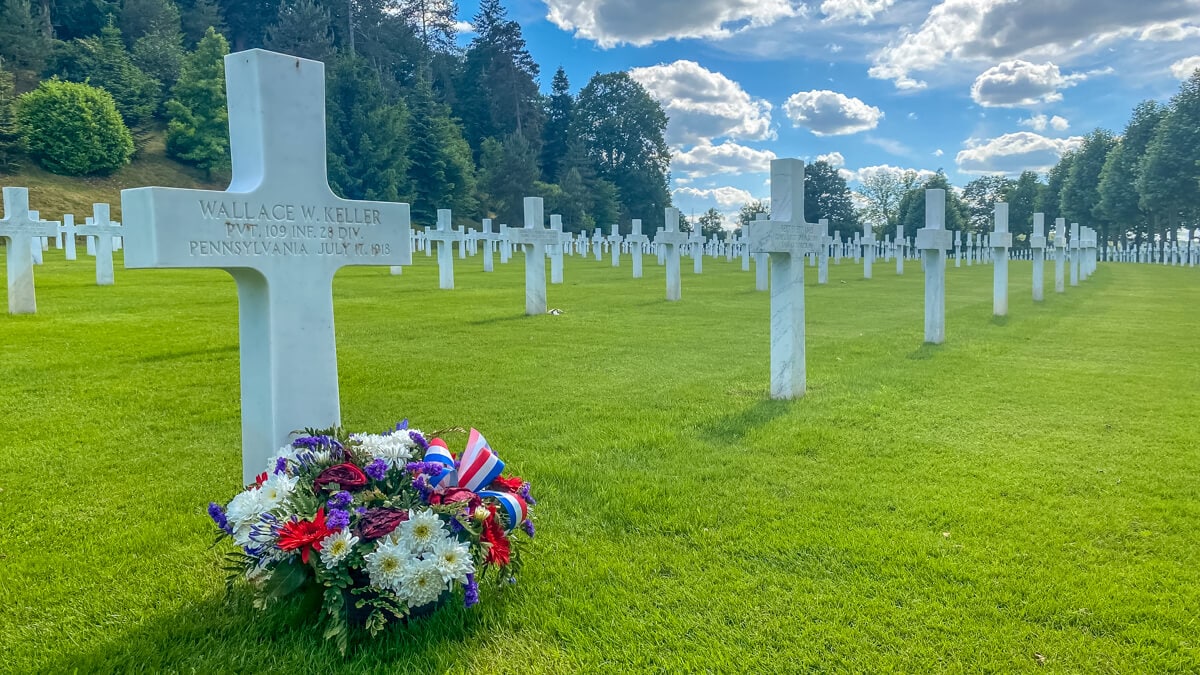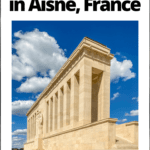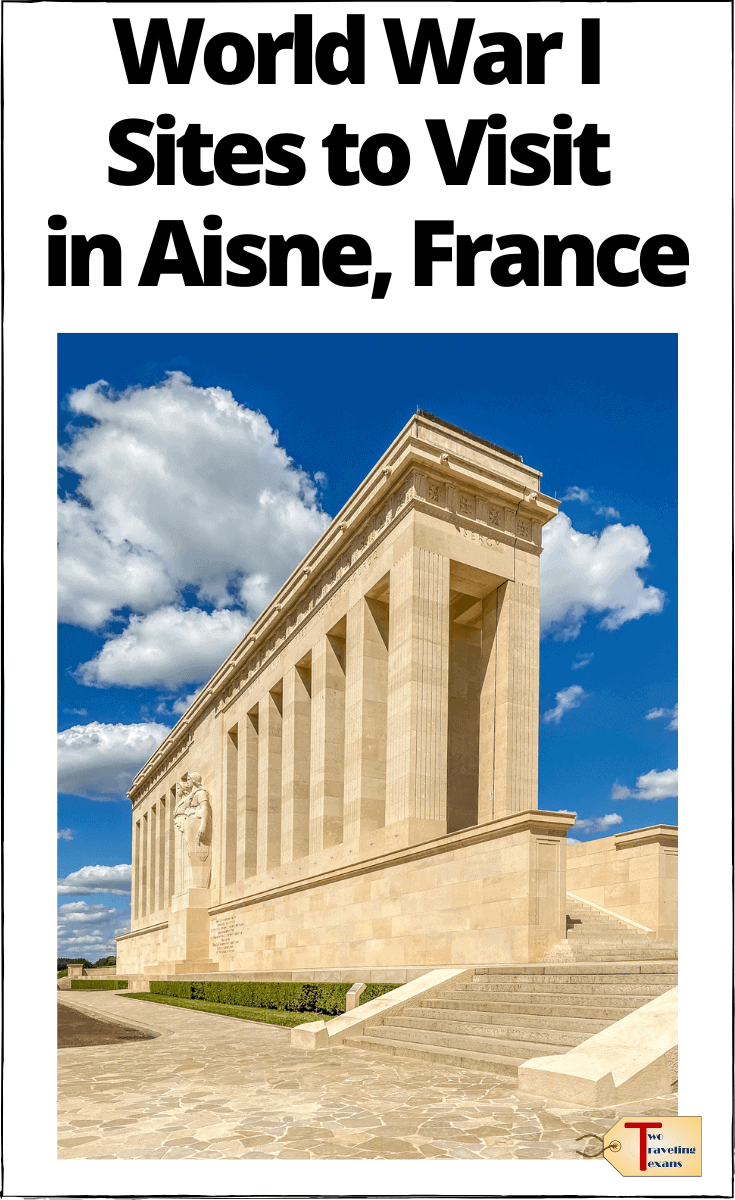Growing up in the USA, I wasn’t taught much about World War I or The Great War as it is known across Europe. In school, I learned about how it started and how it ended but that was about it.
I thought the best way to learn more about World War I would be to go to places where the fighting took place. One of those places is the department of Aisne in France.
We spent a few days visiting World War I sites in Aisne and it was quite thought-provoking. Let me share more details about the places we visited and what we learned.
Note: Our trip to Aisne was sponsored by Aisne Tourism. All opinions are mine. This post also contains affiliate links, please see disclosure for more information.
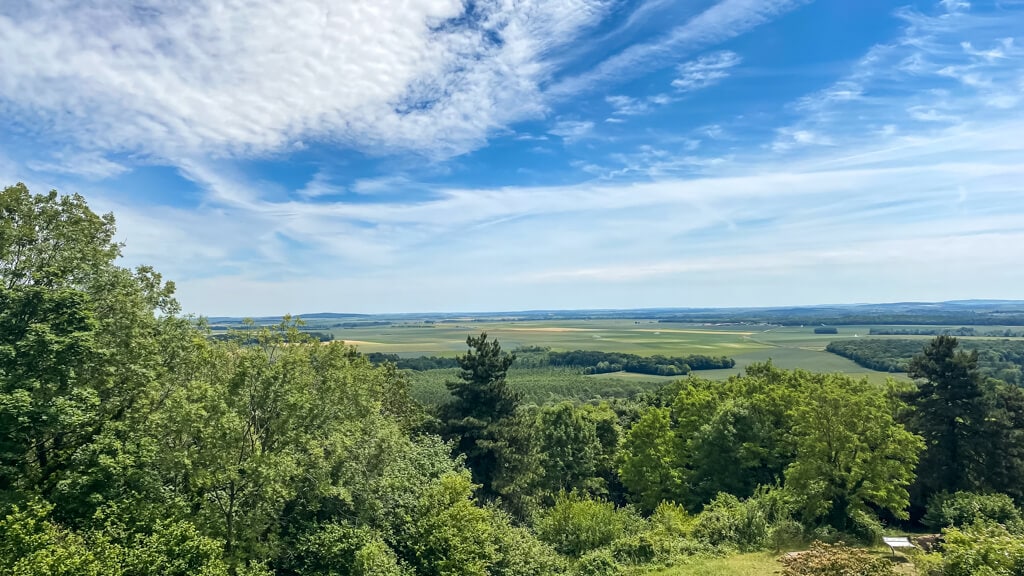
Contents
The Great War in Aisne
During World War I, heavy fighting took place in Aisne as it is strategically located on the route to Paris. Troops from Britain, the USA, Canada, Australia and other countries were needed to help the French eventually overcome the German aggression.
The area was devastated and much had to be rebuilt after the Great War. Even a hundred years later, you can still see evidence of the fighting and feel the impact the war had on the area.
World War I Sites in Aisne
It is not possible to include all the sites in Aisne with a connection to World War I because there are just too many. As an American, I prioritized those with ties to the US. Here I will include places we visited and others that we would like to go to on our next trip to Aisne, grouped geographically.
For many of these sites, you will need to drive as they are located outside cities and not easily accessible by public transportation.
Chemin des Dames

The Chemin des Dames, or the “ladies’ path” in English is a local road that runs along a ridge between the valleys of the Aisne and Ailette rivers for about 20 miles. It gets its name because it was the route that Adélaïde and Victoire, daughters of Louis XV known as Ladies of France, would take to go from Paris to Château de Boves.
In 1814, the Battle of Craonne saw Napoleon’s army beat the Prussians and Russians here. During World War I, its strategic importance made it the staging ground for several major battles that took place between 1914 and 1918.
Because this area was the scene of such intense fighting, casualty numbers were high on all sides. You can still see this today. As you drive along the Chemin Des Dames, you will pass more war memorials, cemeteries, and battle sites than I can list here. I would recommend allowing at least a day (ideally a few) to explore the area.
If you would like to spend more than a day along the Chemin Des Dames, you can stay nearby at the Hotel du Golf de l’Ailette. It’s a lovely lakeside hotel with lots of amenities. Read my detailed review of Hotel du Golf de l’Ailette or you can find more reviews on Tripadvisor here and check the price and availability here.
Caverne du Dragon
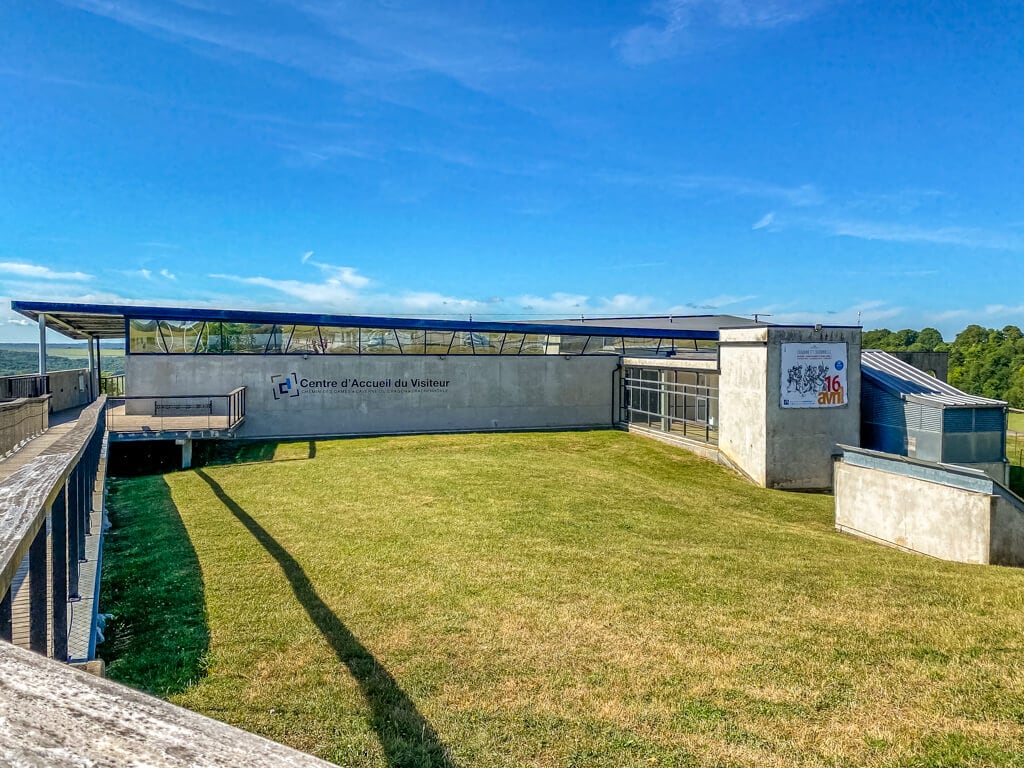
What was an old stone quarry, in operation from the 16th to the 19th century, became underground barracks for soldiers fighting on the Chemin des Dames during World War I. The Germans gave it the name the Dragon’s Lair (Drachenhöhle in German) which translated to Caverne du Dragon in French.
In 1915, the Caverne du Dragon was taken over by German troops, then in 1917 the French recaptured it. Soon after, both sides were using the caves separated by internal walls. The war was going on underground, just as much as it did above. Thanks to help from the British the Caverne du Dragon was definitively taken by the French on 23rd October 1918.
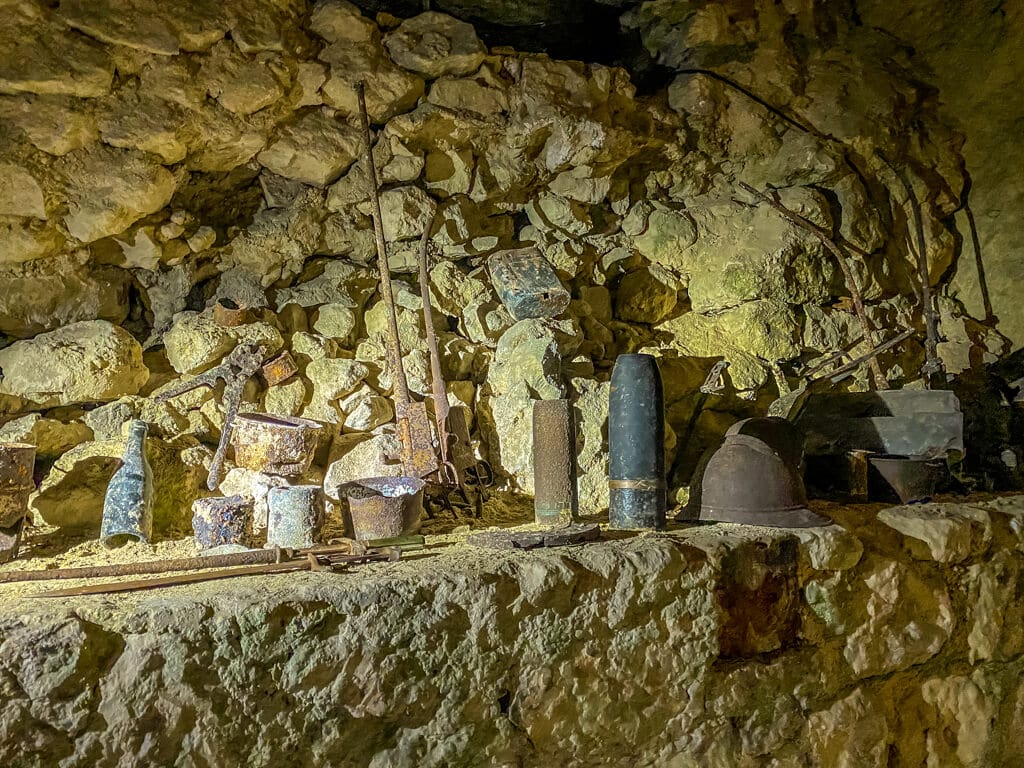
During the time the Germans occupied the quarry, they installed electricity and a well for fresh water. It became a complex with command posts, barracks, a first aid station (although some of the medical issues they were treating were quite severe), and a chapel.
Above ground, there is a modern museum opened in 1999 where you can learn more about battles that took place on the Chemin des Dames. You can go down into the cavern (it is wheelchair accessible) more than 45 feet below ground and see where the soldiers lived.
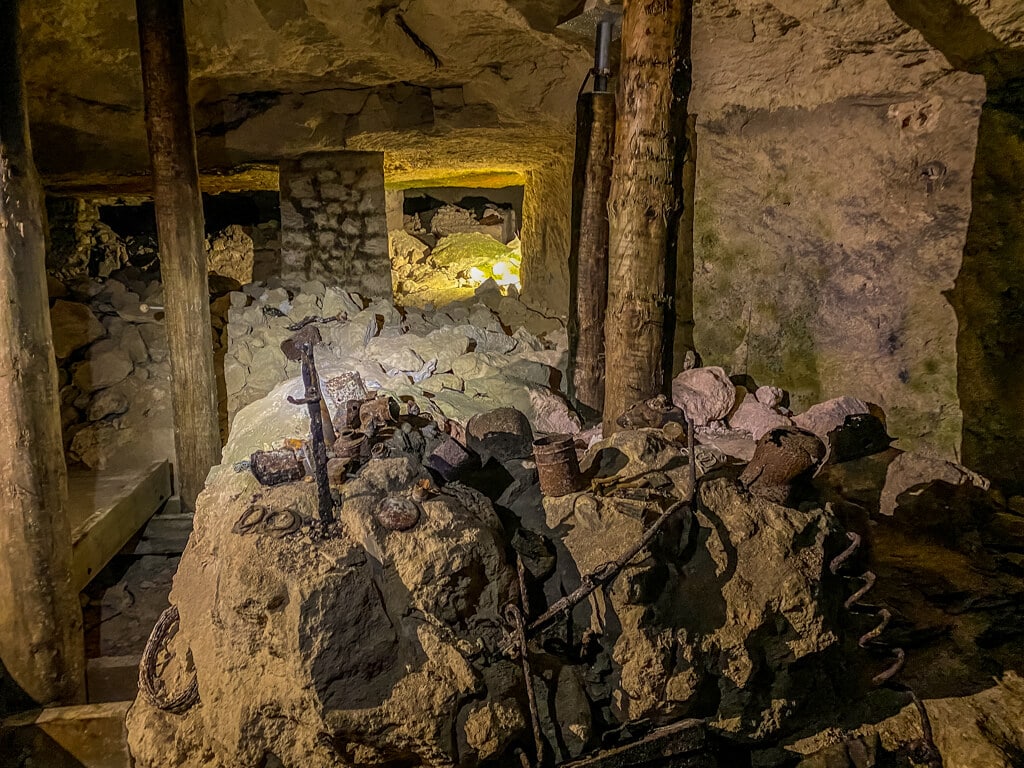
It reminded me a bit of the Deep Fan Bay Shelter in the Dover Cliffs, but it was much bigger. We were expecting a cavern. What’s actually there is a huge complex of tunnels and rooms.
The conditions were more dire in the Caverne du Dragon. They also had more artifacts and photos to help visitors visualize what life was like in the tunnels. Our guide had lots of personal stories that were powerful.
Just outside the entrance to the museum, there is a striking sculpture along with views over the countryside. This sculpture called “They Didn’t Choose Their Graves” was originally made by Haim Kern in 1998 for the 80th anniversary of the Armistice. It was placed nearby at Plateau de Californie and stolen in 2014. The artist created the piece you see today in 2017.
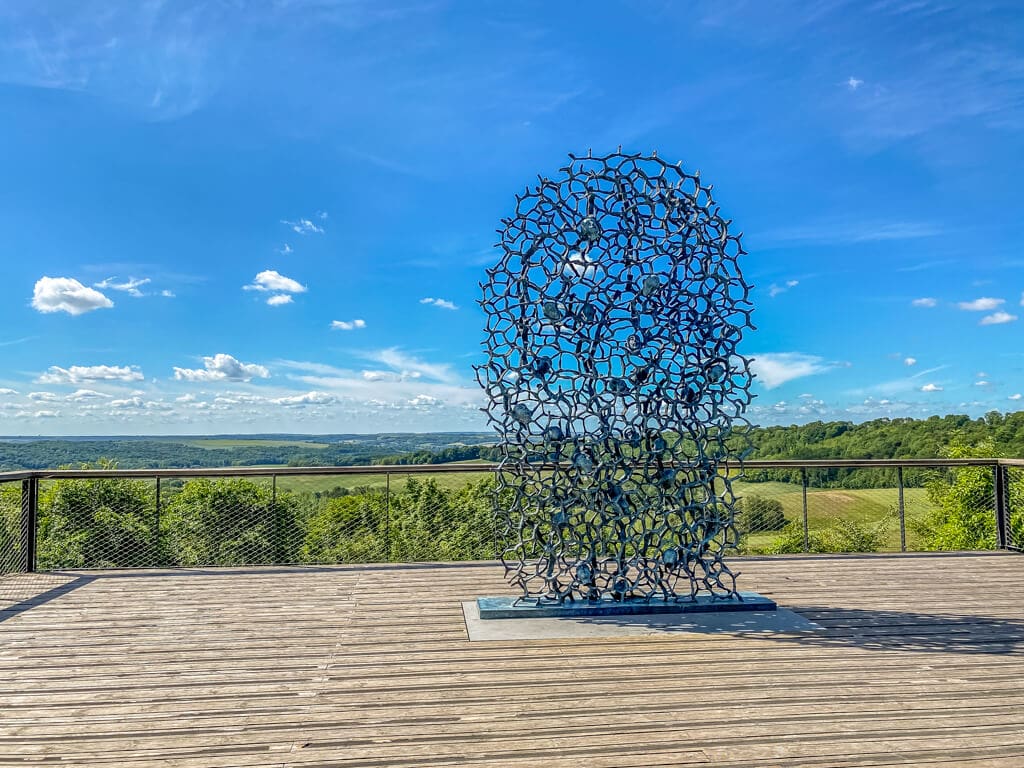
You can see the Caverne du Dragon as part of a guided tour (lasting 1 hour 15 minutes) for €9. Keep in mind it is 54 °F in the caves, so you will need a sweater or jacket even in the summer. Get more details about visiting here.
Plateau de Californie

The area now called Plateau de Californie was purchased by Henri Vanier, one of the investors in the Pommery Champagne house, in the 19th century. He built an extravagant house with a small zoo and gardens with exotic trees and plants from the USA. It became known as Jardin de Californie which translates to Garden of California.
Heavy fighting and casualties took place here during World War I. After the war, it was declared a red zone, meaning there was too much metal in the soil (from shells, shrapnel, and bullets) for it to be cultivated. It was purchased by the French government, renamed Plateau de Californie, and made a remembrance site.
There are trails with information boards so that you can explore the area and learn more about what took place here. Some of the trenches are still visible. You need to stay on the marked path as there could still be small chambers that could cave in.
You get expansive views of the area from the path when there are breaks in the trees. If you want a better look, there is also an observatory that you can climb up.
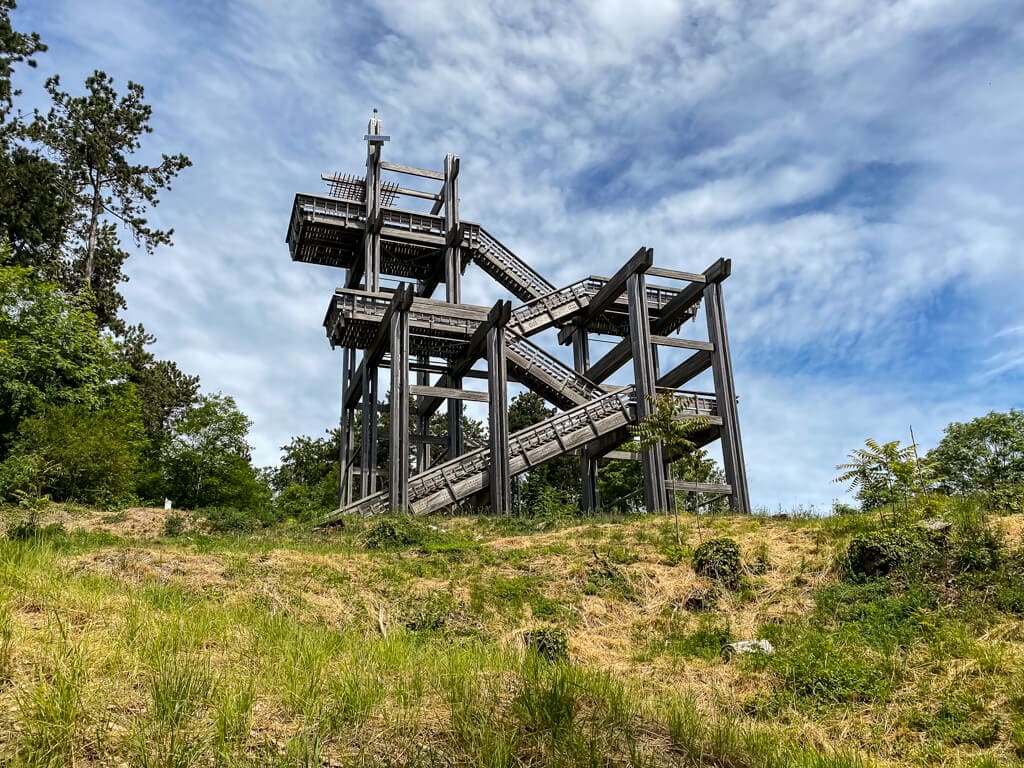
As noted above, there also used to be a large sculpture called “They Didn’t Choose Their Graves” by Haim Kern, but it was stolen in 2014. The artist recreated the work and it was placed by the Caverne du Dragon in 2017. There is also a small piece of the sculpture on a concrete block at Plateau de Californie.
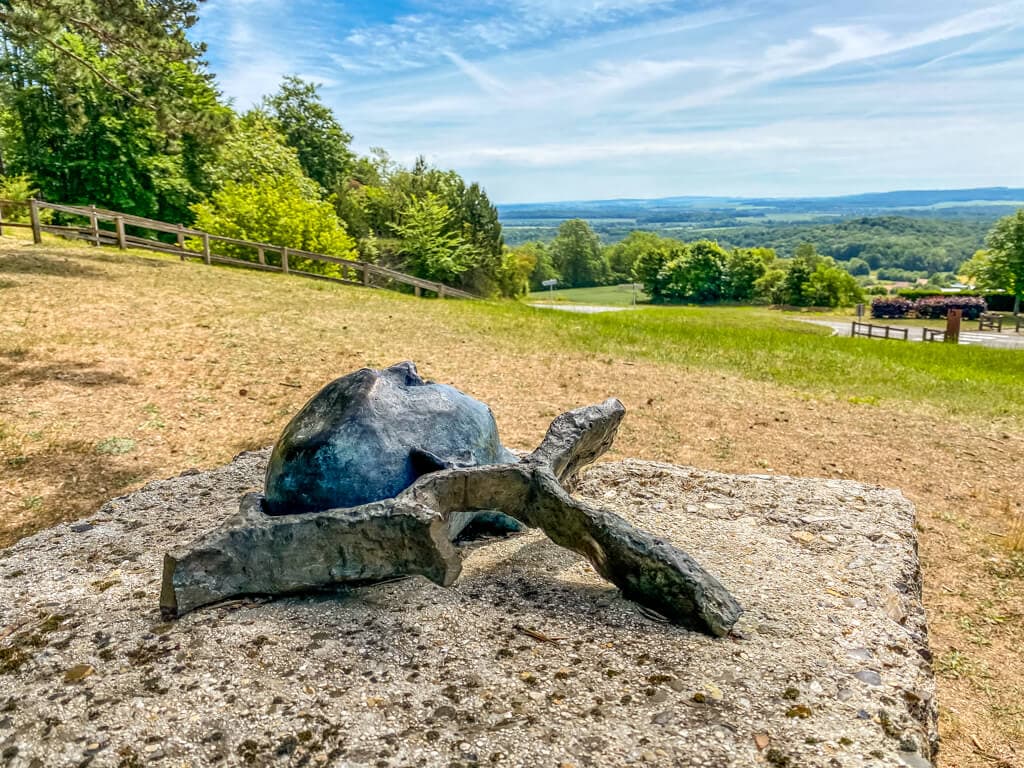
It is free to visit Plateau de Californie and it has a small parking lot.
Vauclair Abbey
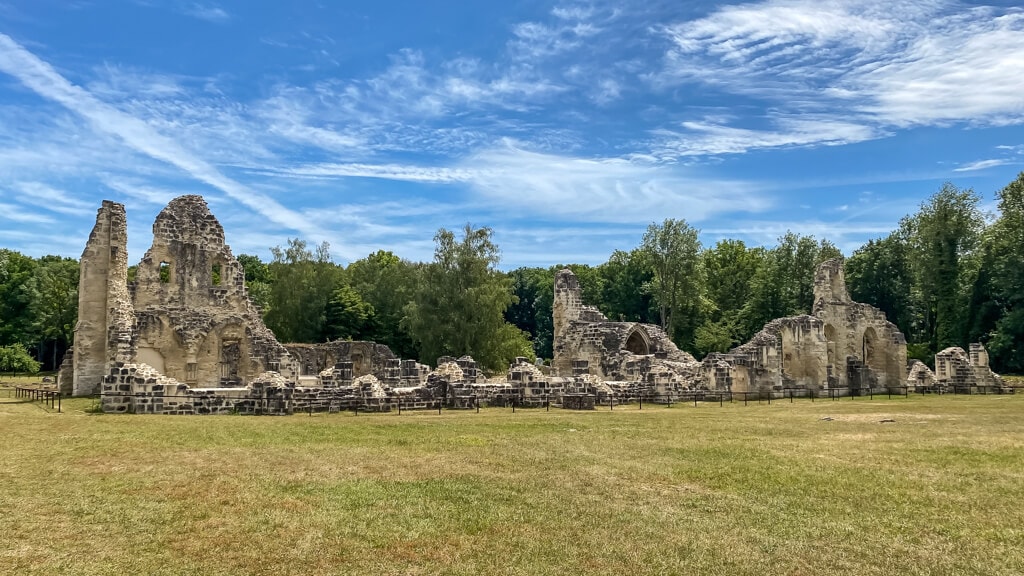
Thanks to excavations we know this site has been inhabited since at least the Iron Age. The ruins that you see today are from an old Cistercian abbey founded in 1134 by St. Bernard of Clairvaux.
The abbey was damaged during the Hundred Years’ War and the 16th-century French Wars of Religion, but managed to carry on until the French Revolution in 1789. At that point, it was demolished and sold as property of the State. What remained was almost totally destroyed in 1917 during the fighting by the Chemin des Dames.
In addition to the ruins, there is a garden near to the presumed site of the old infirmary. It was recreated following the plan of the first monastic gardens with over 400 species of medicinal plants.
If you have time, it’s also worth visiting the lake a short walk from the abbey ruins.
Fort de Condé
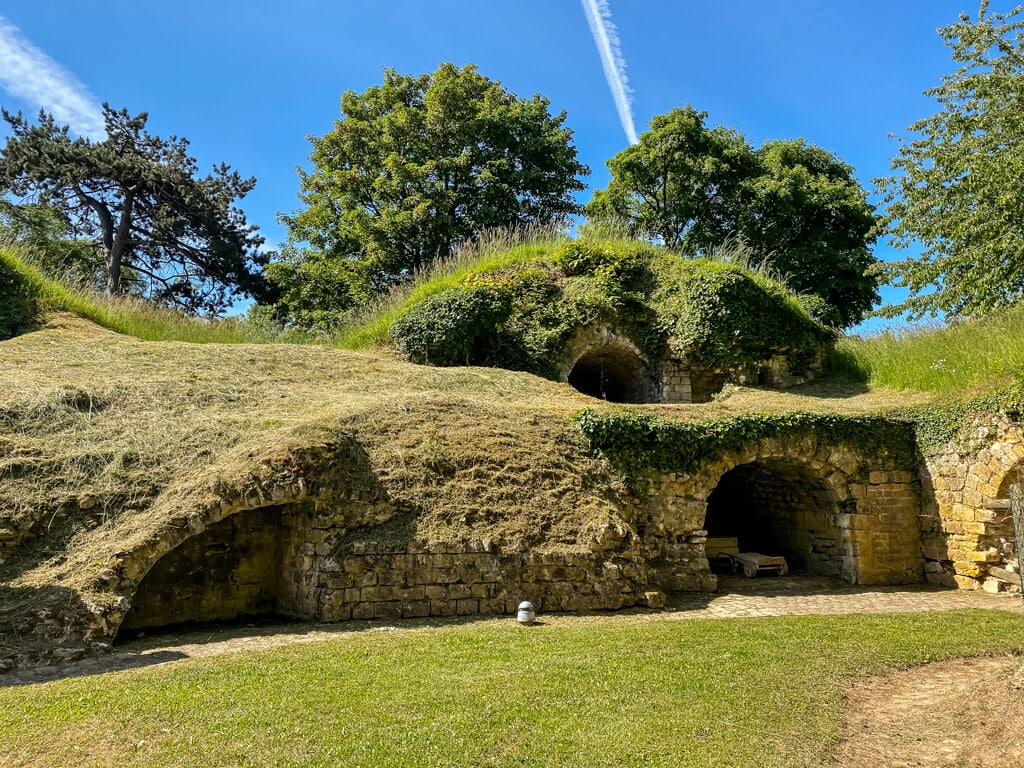
The Fort de Condé was built between 1877 and 1883 to defend the area between the towns of Soissons and Laon. By the time World War I started the fort was no longer in use, but because of its prominent location it was a coveted objective throughout the war. It changed hands between the French and German armies several times.
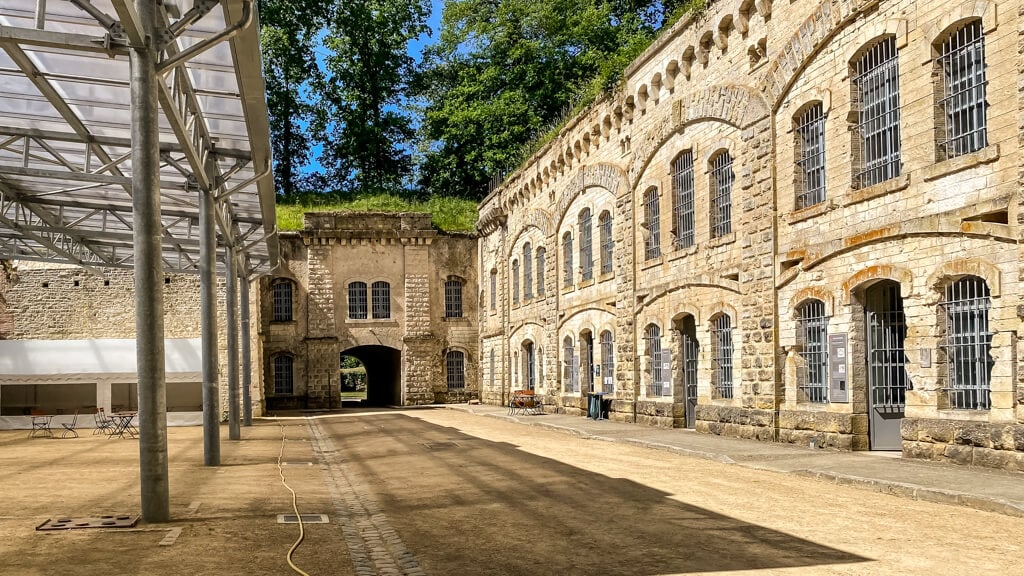
You can visit the fort and explore the rooms, courtyards, and tunnels. Visually it is beautiful with the greenery taking over the ruins in some places. From the top, you have views over the countryside.
There are signs in English so you can learn more about the fort. The information about what happened here during World War I is minimal, but there is a lot about the fort’s defenses and architecture, which seemed advanced for its time.
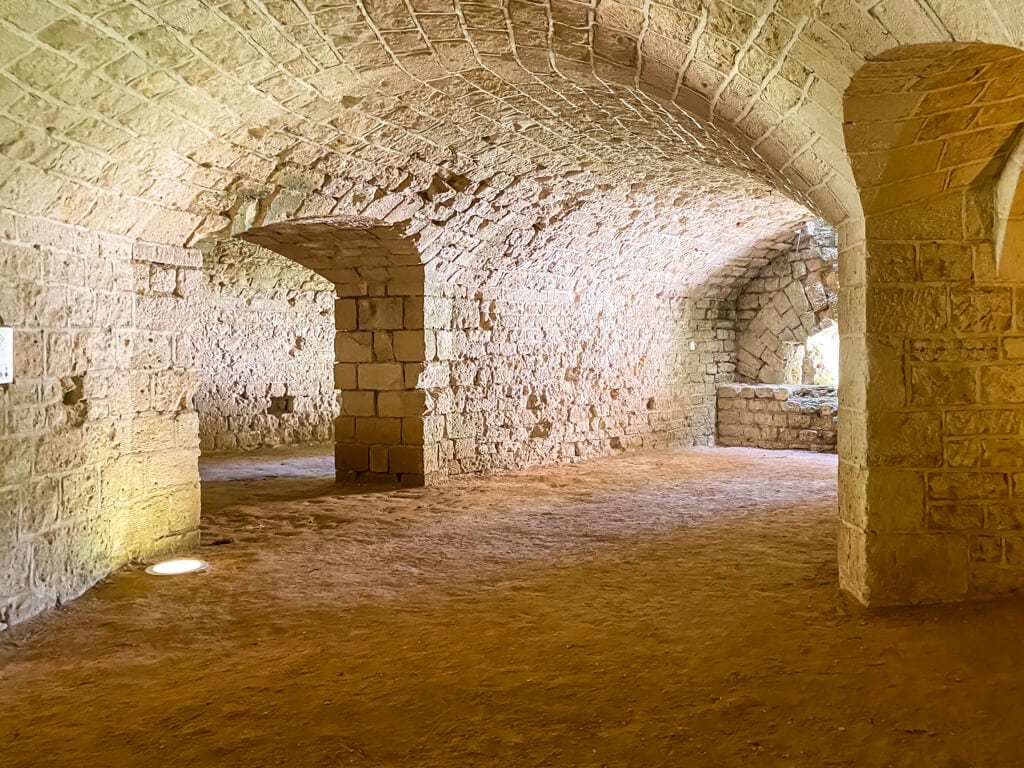
Admission is €6.50 per adult. Keep in mind that the roads leading to Fort de Condé are a bit narrow.
Note: Fort De Conde is a bit outside the Chemin Des Dames area, it takes about 30 minutes to drive there.
Saint-Quentin
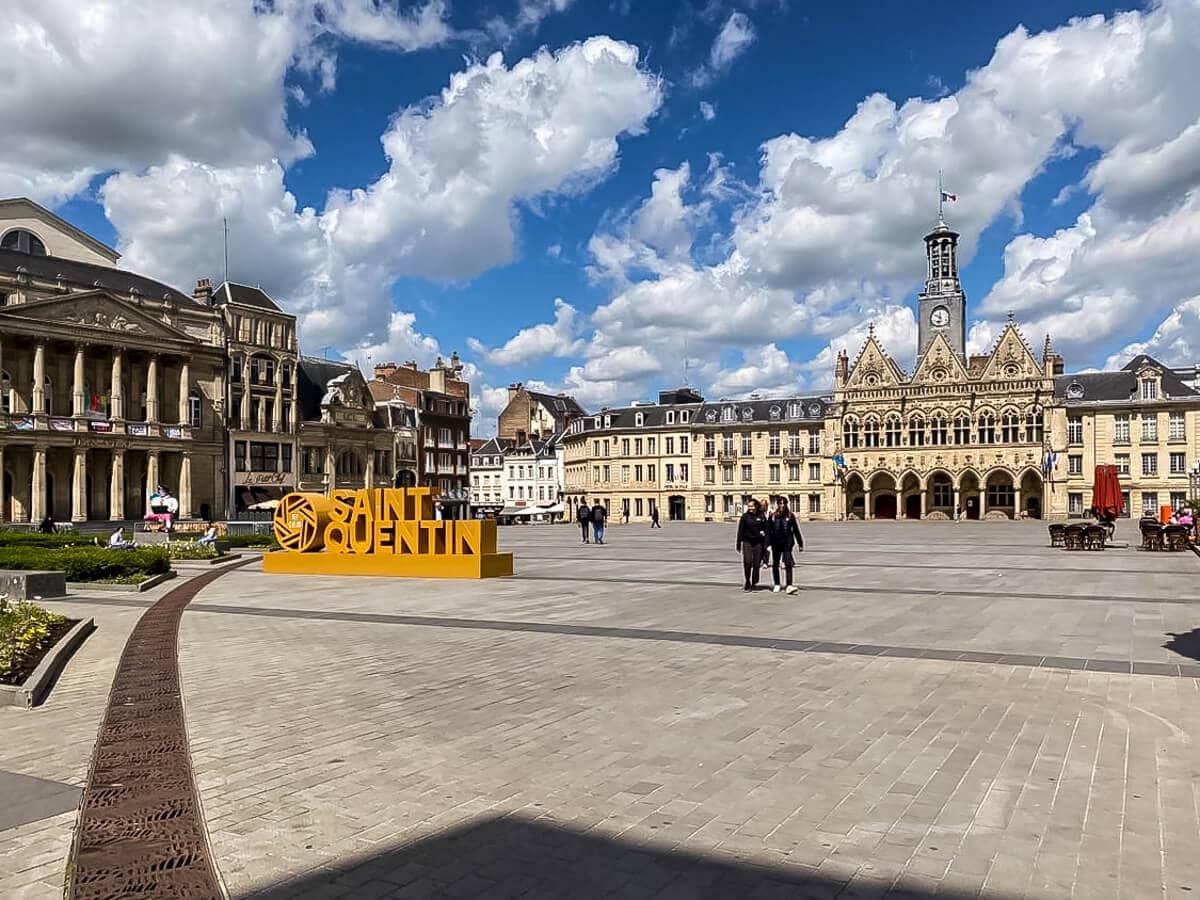
Saint-Quentin has a history going back to Roman times. During the Middle Ages, it was a pilgrimage site for those who wanted to visit Saint Quentin’s tomb.
While there are still a few medieval buildings still standing, most of the town was rebuilt in the Art Deco style after 80% of the buildings were damaged during World War I. There was intense fighting in the area as the Hindenburg Line went through the town. Residents were evacuated further north and to Belgium as the German army occupied the town and established their defenses.
The Hindenburg Line was a German defensive position built during the winter of 1916–1917 on the Western Front to replace the old front line and prevent a resumption of the Battle of the Somme. It was considered impenetrable with a series of trenches, barbed wire, machine gun positions and more, ten miles deep.
This placed Saint-Quentin right at the heart of the battlefield. Although the Hindenburg Line was thought to be unbreakable, the Allies managed to do so at the Saint Quentin Canal (more on that below).
When the people returned to Saint-Quentin, they found that the war had devastated their town. While they were rebuilding, the people of Saint-Quentin took the opportunity to adopt the new Art Deco style that was popular at the time. As a result, the town has some of the finest, and most tightly packed examples of Art Deco architecture you will find anywhere.

When you are in the area to see the World War I sites, it’s also worth going to the Town Hall, Basilica, and the Art Deco Palace (Le Palais de l’Art déco). Take some time to stroll around the main streets in the center of the town and see how many examples of Art Deco you can spot. Even some of the street furniture is in the style!
If you get the chance, you might like to see one of Saint-Quentin’s best examples of the Art Deco style at the Buffet at the Train Station. This is only accessible on a guided tour booked with the tourism board (in the main square, near the Town Hall).
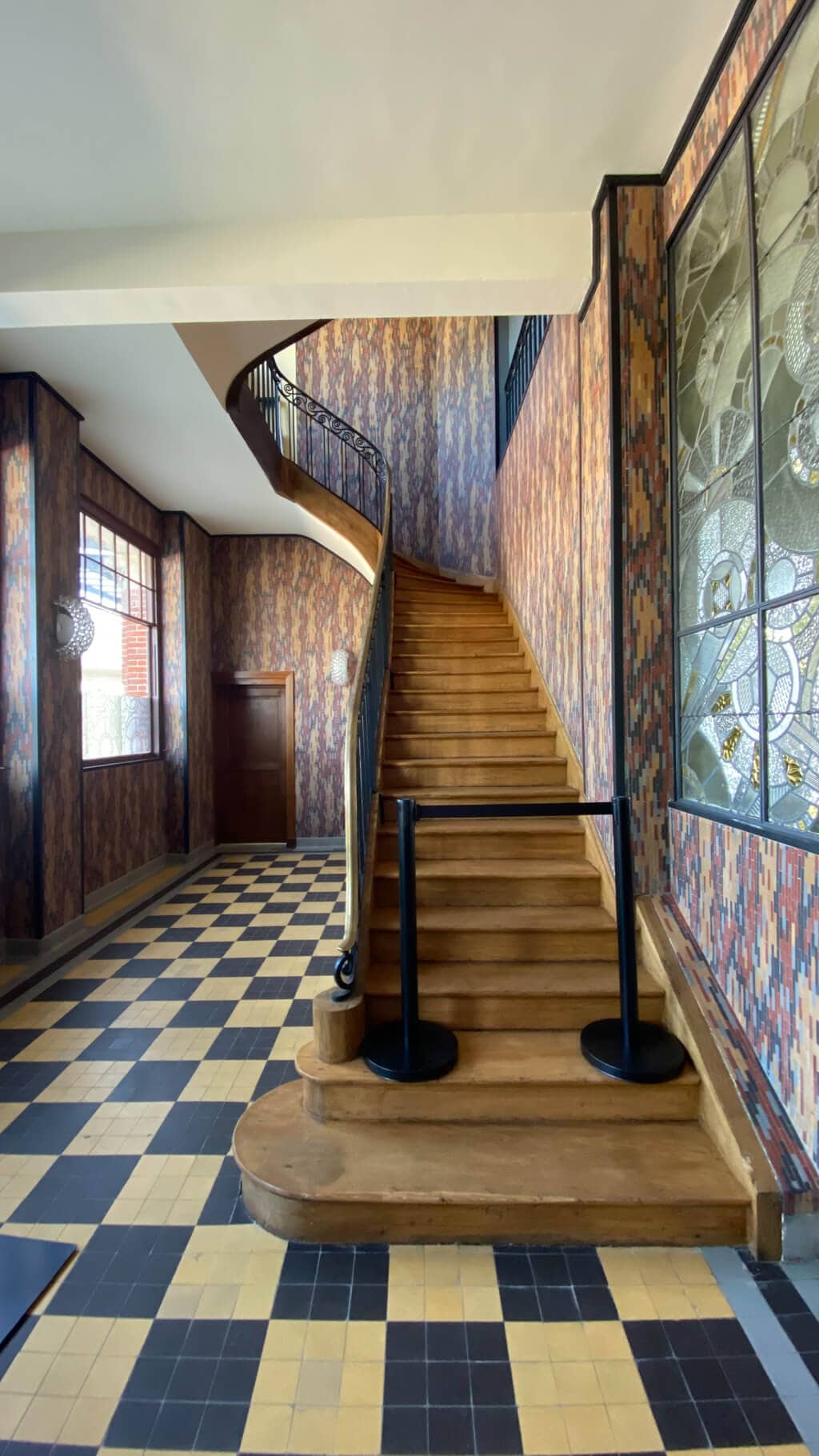
While in Saint-Quentin, you can stay at the very affordable Le Florence Hotel in the town center. Read reviews here and check price and availability here.
Alternatively, if you are looking for something more luxurious, check out Hotel le Picardy here. Note that they do charge a refundable damage deposit.
Saint-Quentin War Memorial
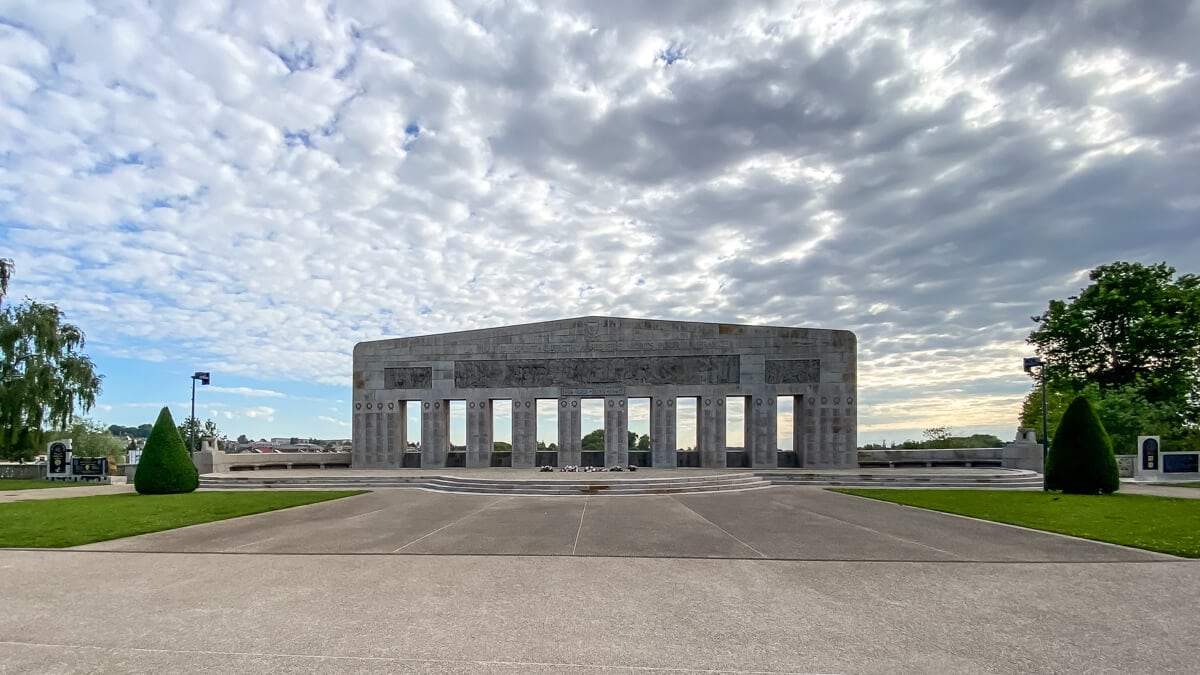
Located near the train station, you can’t miss the Saint-Quentin War Memorial designed by French architect Paul Bigot. It displays the names of locals who died in World War I along the wars in 1870 and 1577.
The memorial was opened July 31, 1927 and is larger than it looks in pictures. The setting is dramatic overlooking a nature reserve. It’s definitely worth walking over to it and taking a closer look.
Riqueval Bridge and Memorial
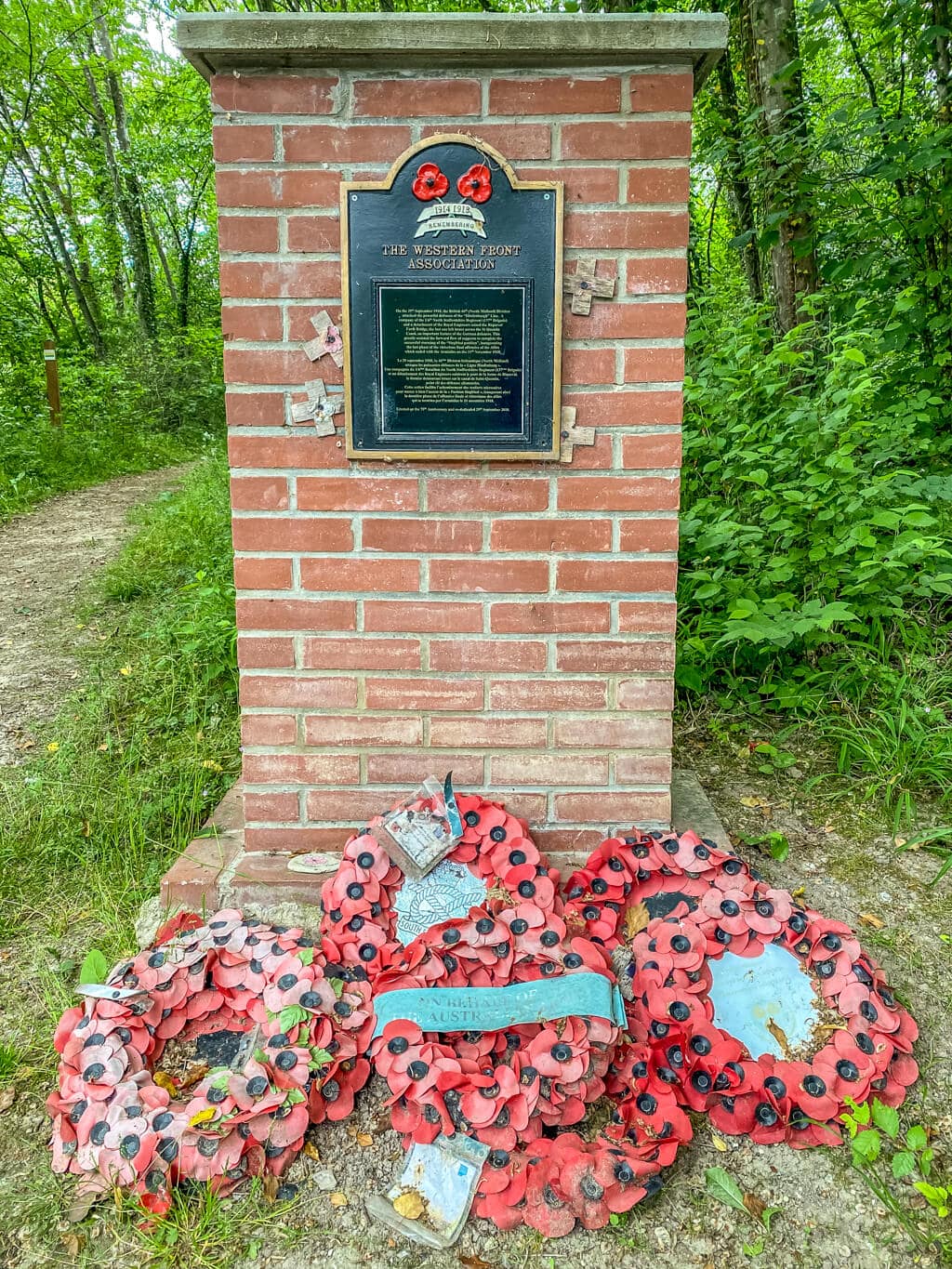
About a 15 minute drive from Saint-Quentin is the Riqueval Bridge where the Battle of the St. Quentin Canal took place at the end of September 1918. The objective was to break through one of the most heavily defended stretches of the Hindenburg Line, which in this area used the St Quentin Canal as part of its defenses.
Ten men went on a daring raid across the bridge to take a German machine gun post and prevent destruction of the bridge. In the end, it was the first breakthrough of the Hindenburg Line, which was thought to be impossible.
It was a crucial battle of the First World War and required the involvement of British, Australian and American forces. With the Hindenburg Line breached, German Command felt the war could no longer be won.
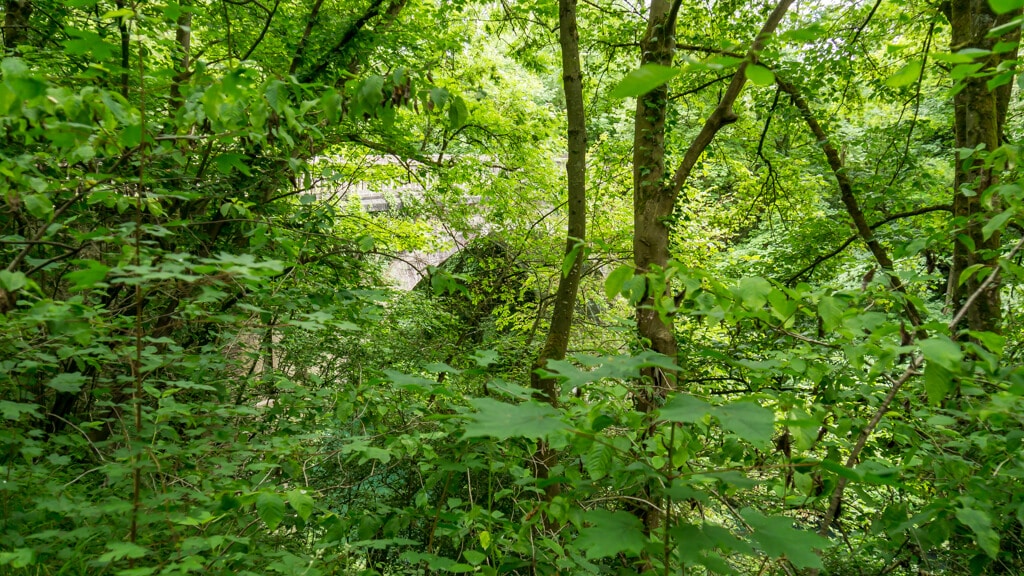
You may have seen a photo taken following the capture of Riqueval Bridge on display at the Imperial War Museum in London. The Riqueval Bridge looks much different now than it did in the famous photograph. The trees cover the banks and it is hard to even get a view of the bridge unless you are standing on it. There is also a small memorial that was rededicated in 1918 after being repaired.
It is free to visit the Riqueval Bridge and there is a small parking lot just across the street.
Riqueval Tunnel
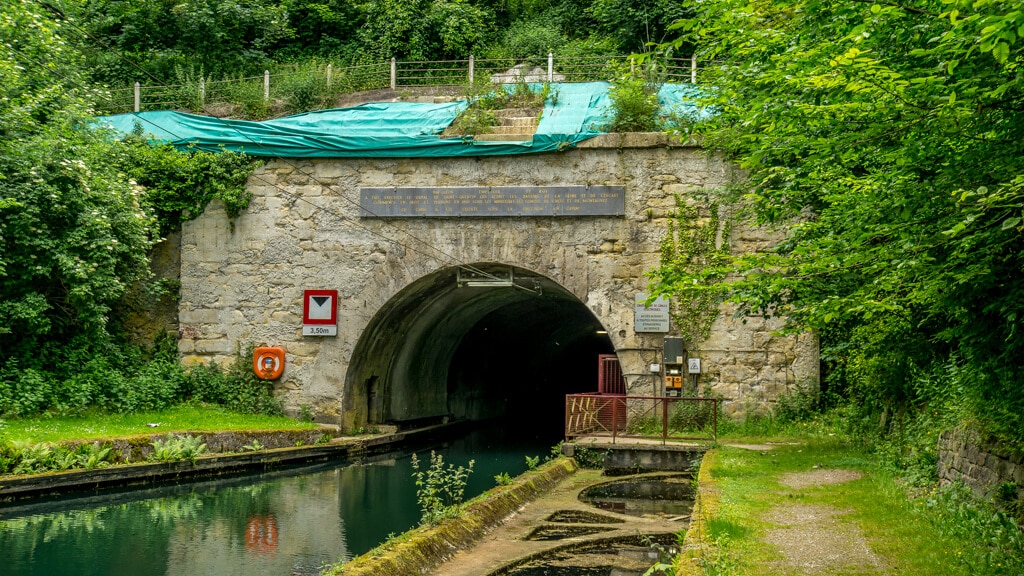
A few minutes drive further north from the Riqueval Bridge is the Riqueval Tunnel. Hundreds of prisoners of war took eight years to dig the 3.7 mile long tunnel during the reign of Napoleon I. Since there is no ventilation in the tunnel, barges cannot use their engines inside the tunnel and a special winch boat called the ‘Toueur’ has to pull them through.
During the First World War the Germans turned this tunnel into barracks and the men slept in barges. In September 1918, the tunnel was recaptured as part of the Battle for the Hindenburg line.
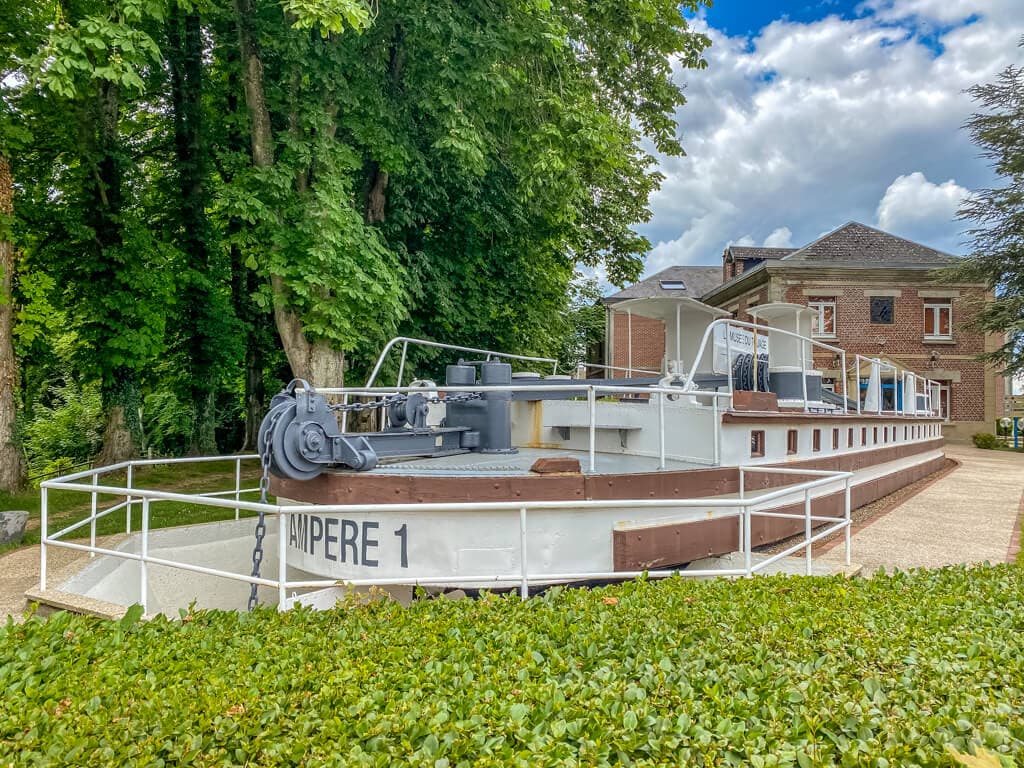
There is a museum here (called Le Musee Du Touage or the Towing Museum in English) but it focuses more on the tunnel and the ‘Toueur’ boats than what happened during World War I. Since we were focused on learning about the Great War, we didn’t go inside the museum but walked down the ramp to get a glimpse of the tunnel.
It is free to see the tunnel, if you want to go into the Towing Museum it is €5. Get more information about the Towing Museum here.
Somme American Cemetery
About 20 minutes north of Saint-Quentin, there is an American World War I Cemetery that contains 1,844 graves of Americans who lost their lives while serving American units attached to British armies or in operations near Cantigny.
The graves are located on a gentle slope, separated into four plots by paths that intersect at the flagpole. There is a chapel with sculptured pieces of military equipment on the outer walls at the eastern end of the cemetery.
Go inside the chapel through the massive bronze door with an American eagle on top. A cross-shaped crystal window lets light into the space. The walls list the names of 333 of the missing. A rosette next to the name means that the body has since been recovered and identified.
It is free to visit the Somme American Cemetery. Get more details here.
If you are interested in American Cemeteries, be sure to read my post about visiting the American Cemetery in Cambridge.
Museum of Franco-American Friendship at Blérancourt
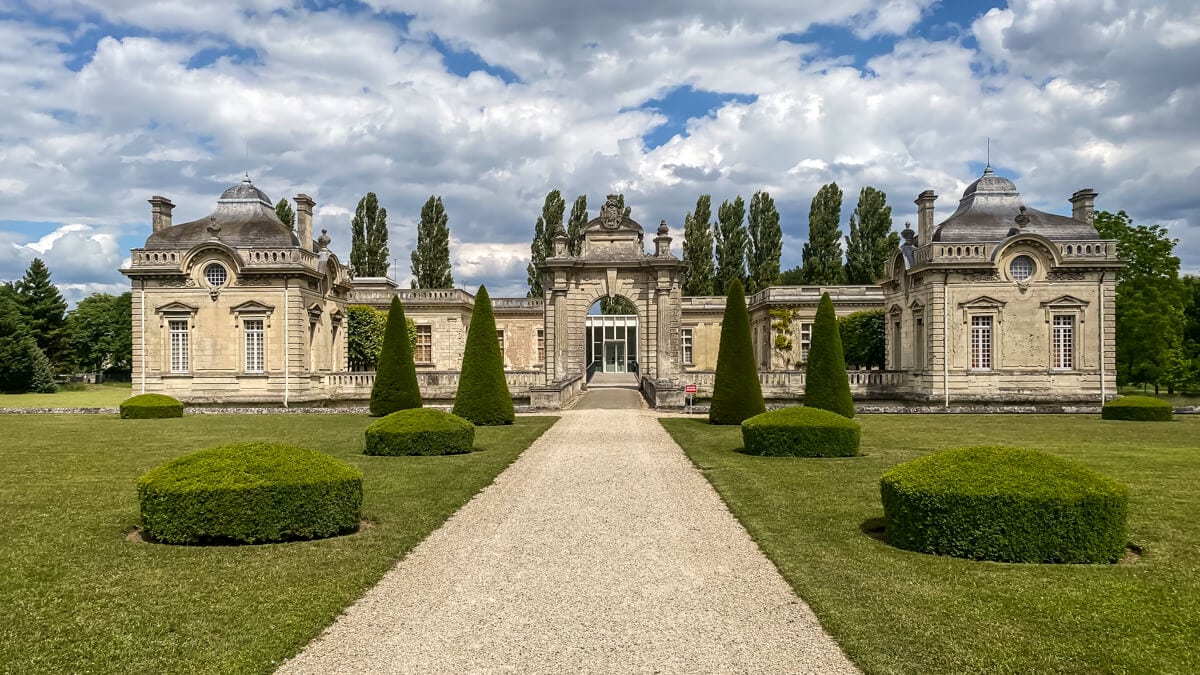
The Chateau de Blérancourt was built in the early 17th century to be the residence of Bernard Potier, an influential and wealthy man. During the French Revolution (1792) it was declared property of the State. A few years later, the central building was taken apart and the estate was sold off in lots. It fell into disrepair and was in ruins even before World War I started and suffered further damage during the war.
Anne Morgan, daughter of John Pierpoint Morgan, bought the romantic ruins of the Chateau de Blérancourt to use as the headquarters for the humanitarian organization, Committee for the Devastated France. Anne, along with about 350 other American women worked to help the civilian population of the Aisne department in France that had been particularly hard hit by World War I.

Now the Chateau has been turned into a beautiful and moving museum founded by Anne Morgan. A bridge has been added along with modern walls and stairs that work well with the remaining ruins to create unique galleries exploring Franco-American relations through three themes – ideals, ordeals, and the arts.
The collection includes 15,000 paintings, sculptures, photographs, objects, artworks, documents, and memorabilia (mostly from the World War I era). Some of the highlights include an American Field Service Ambulance, a study of Liberty Enlightening the World (more commonly known to Americans as the Statue of Liberty by Frederic Auguste Bartholdi), and a representation of a library created by the Committee for the Devastated France for people in the area with some of the actual books that were part of the libraries set up at the time.
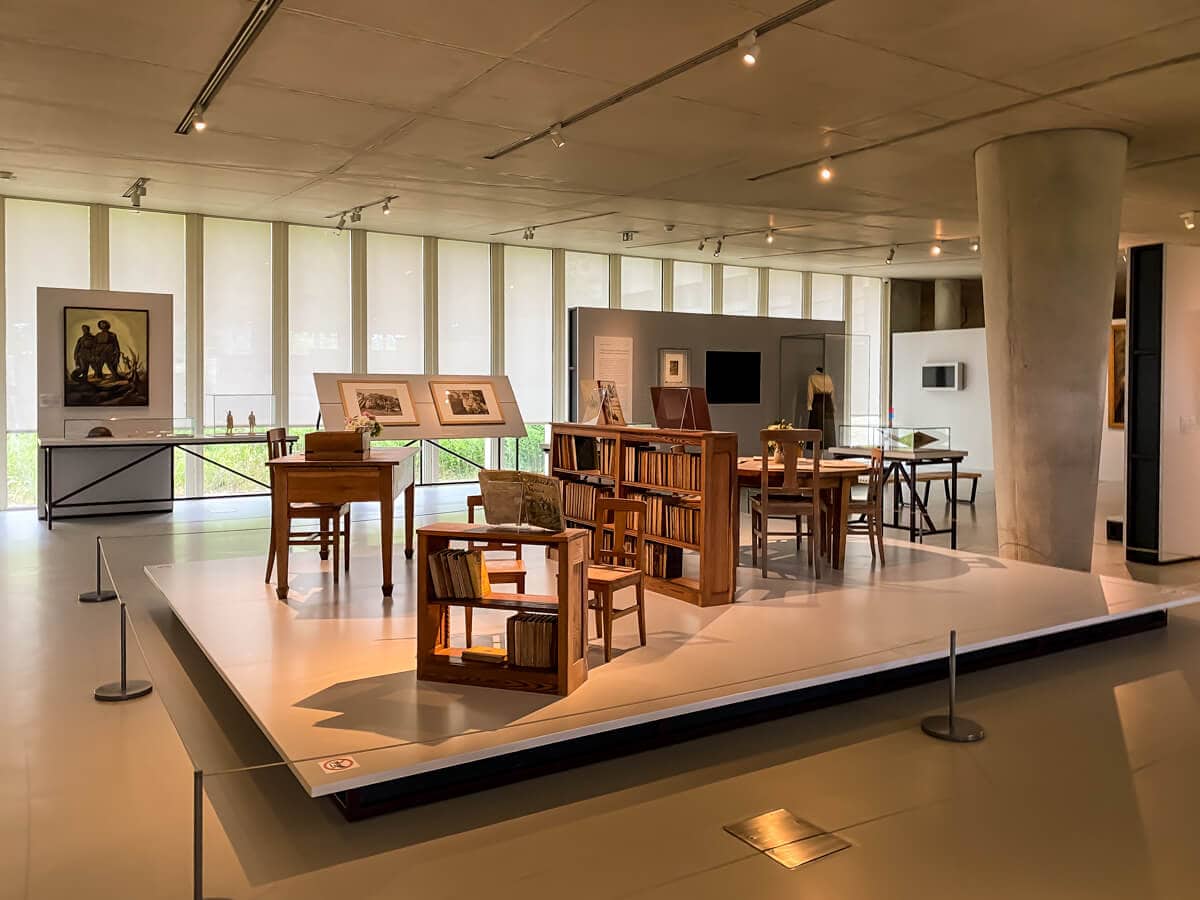
After exploring the museum, be sure to check out the Gardens and Arboretum which are full of plants and trees from the US. Behind the gardens, there is the Path of Remembrance which is an avenue of poplar trees to honor the ambulance drivers from the American Field Service.
I left the National Museum of French-American Friendship and Cooperation inspired and proud of the impact these American women had on the area, but also sad to learn about the conditions and issues civilians in France faced during and after World War I.
Admission to the Blérancourt Museum is €6.00 per person. It is included in the Paris Museum Pass which comes with the Paris Pass. There is no charge to visit the Gardens. Note that the museum is closed on Tuesdays.
Note: The Franco American Friendship Museum is about a 45 minute drive from Saint-Quentin. Trust me, it is worth the journey.
Chateau-Thierry
Château-Thierry is located in the Marne Valley with a landscape typical of the Champagne region. It was part of the Champagne region until the French Revolution and now it is part of the Aisne.
Several important battles took place in the Chateau-Thierry and the surrounding area. It was the first place where American forces got involved in World War I. Chateau-Thierry is one of 64 French towns to have received the Legion of Honour.
If you want to explore the World War I sites around Chateau-Thierry, you can stay at La Marjolaine. It’s a historic chateau with beautiful gardens. Read my detailed review of Chateau de la Marjolaine, or read more Tripadvisor reviews here and check the price and availability here.
While you are in the area, you might also enjoy learning more about the Champagne produced here. We did a tour and tasting at Champagne Pannier.
Chateau-Thierry American Monument on Hill 204
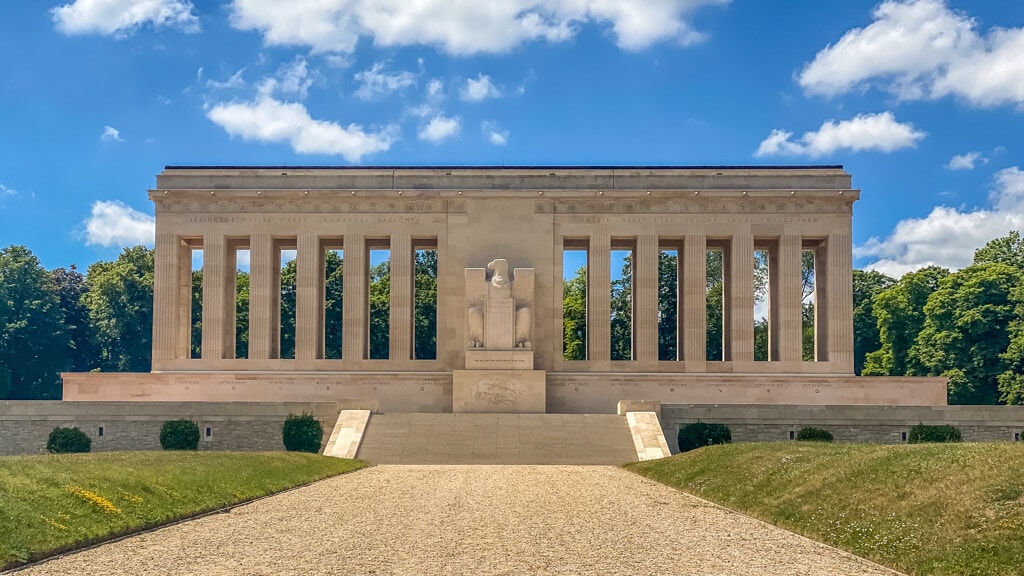
Standing tall on a hill two miles west of Chateau-Thierry is a monument that commemorates the sacrifices and achievements of the Americans and French before and during the Aisne-Marne and Oise-Aisne offensives. Affectionately called The Radiator by locals, it celebrates the alliance between the two countries that made victory possible.
French architect Paul Cret, who served France during the Great War and also established a successful architectural career in Philadelphia, designed the monument. His style follows classical ideals like those seen in ancient monuments.
The monument has a large double colonnade rising above a long terrace. On its west facade are heroic sculptured figures, Columbia and Marianne, symbols of the United States and France, respectively, holding hands to demonstrate the friendship between the countries.
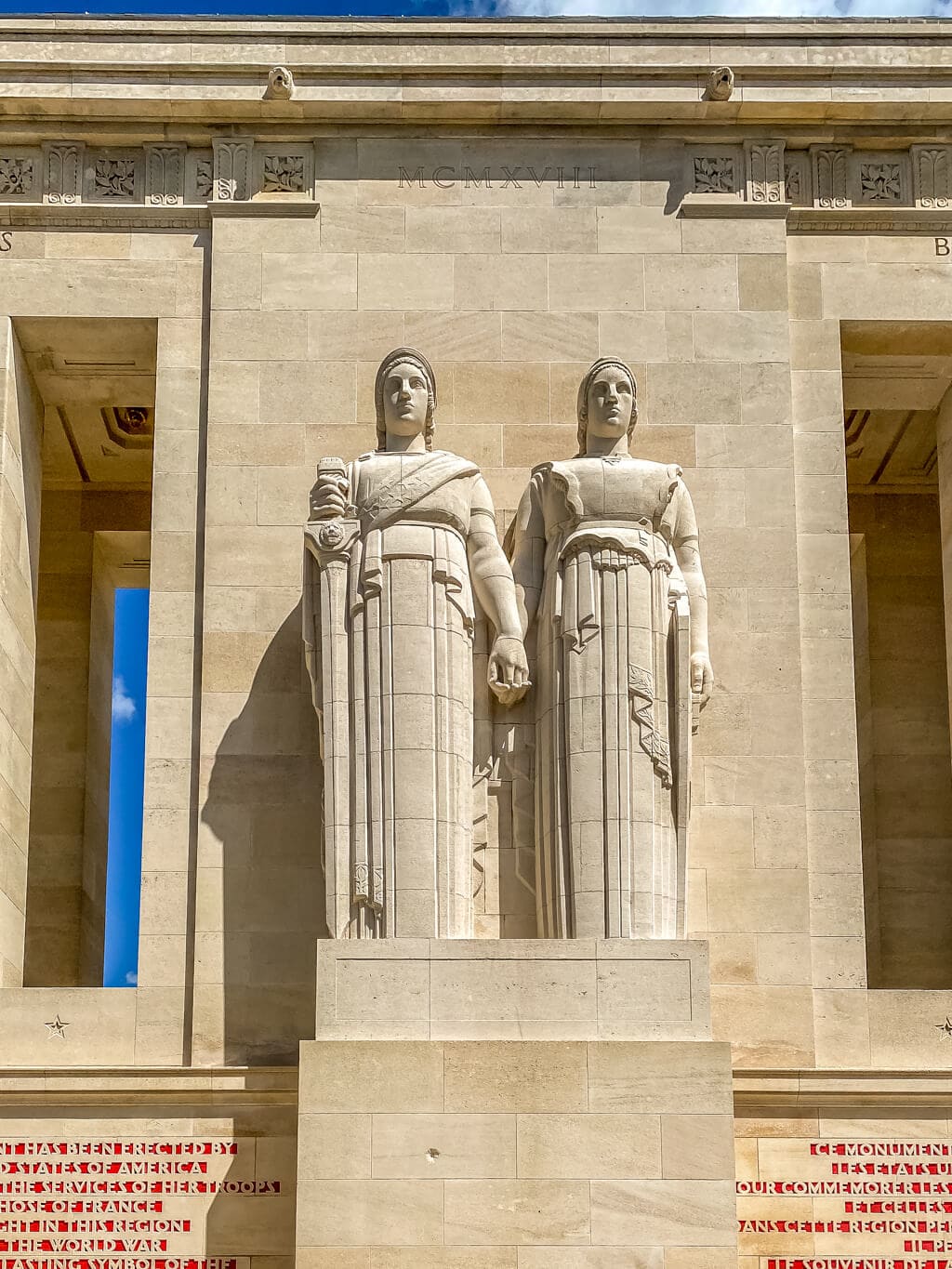
On the other side, you will find a map showing American military operations in the area and an orientation table pointing out the significant battle sites. Each regiment is also listed with its respective insignia. In the center, there is a large sculpture of an eagle.
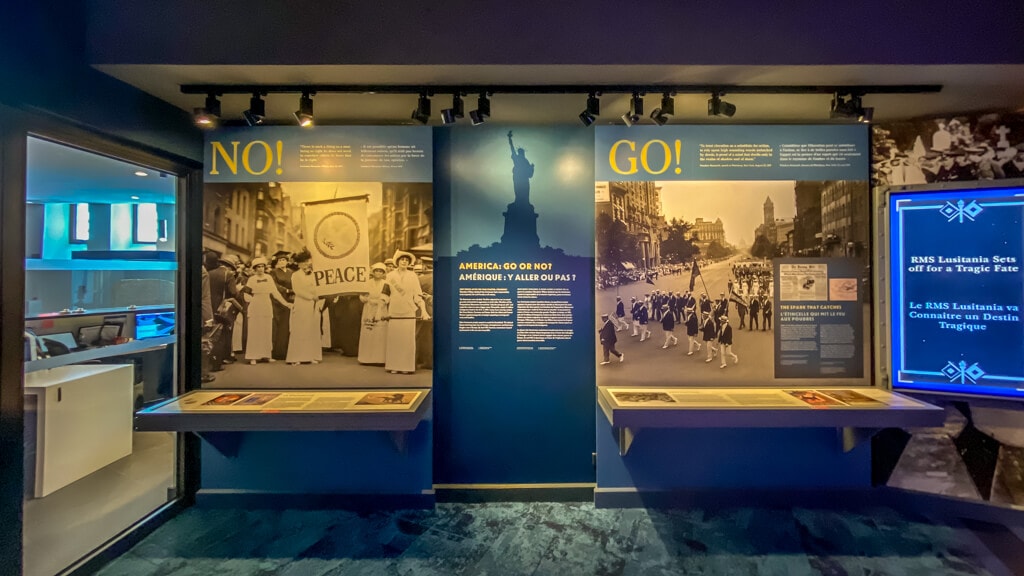
Inside the Monument is a museum with displays that tell the story of the First World War from a US perspective. It starts by explaining how the US was hesitant to get involved in the war and ends with a moving display about the casualties of the war. The exhibit about trench warfare was also powerful as it used art about the war.
It is free to visit the museum and monument. Get more information here.
Belleau Wood Marine Monument

During the Battle of Belleau Wood, American Marines were able to stop the Germans from advancing but it wasn’t without cost. It was one of the bloodiest and most ferocious battles U.S. forces would fight in World War I. United States forces suffered more than 9,000 casualties, including 1,811 killed, many who are buried at the Aisne-Marne Cemetery nearby.
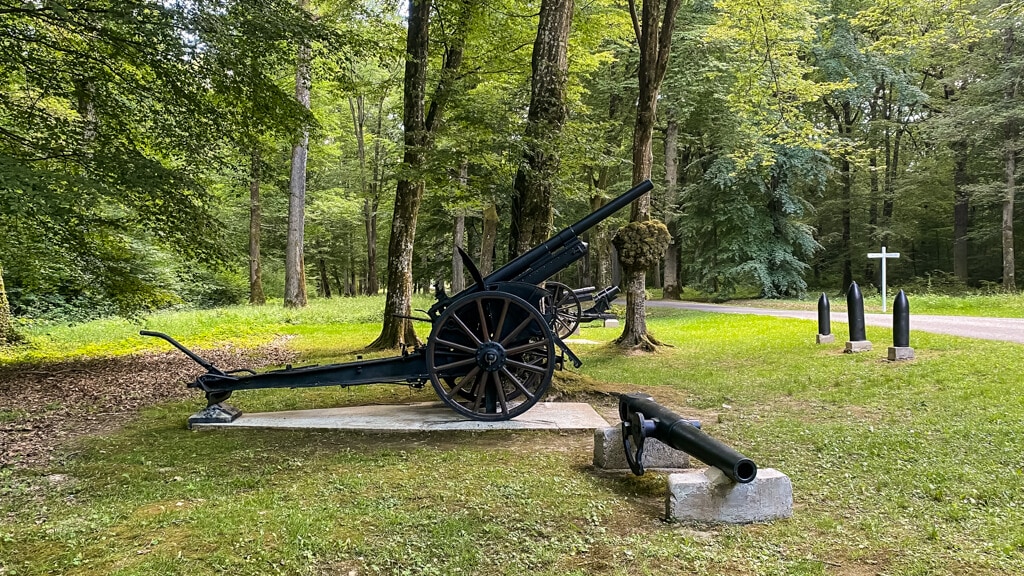
Just days after the battle ended, the Commanding General, French 6th Army, officially renamed Belleau Wood as “Wood of the Marine Brigade” to demonstrate his appreciation for their gallant efforts. Two Marines and Two Navy Officers were awarded the Medal of Honor and another 152 Marines were awarded the Navy Cross.
Now there is a monument that commemorates the actions of the 4th Marine Brigade of the U.S. Army’s 2nd Division in the center of the road that goes through Belleau Wood. It was done by Felix de Weldon who also did the Iwo Jima Memorial in Arlington, Virginia.
Around the monument there are various relics of the war including weapons found in the area. A short walk away you can find the remains of the hunting lodge which was used as a command and observation post by both sides.
It is free to visit Belleau Wood and there is parking right by the Marine Monument.
Aisne-Marne American Cemetery
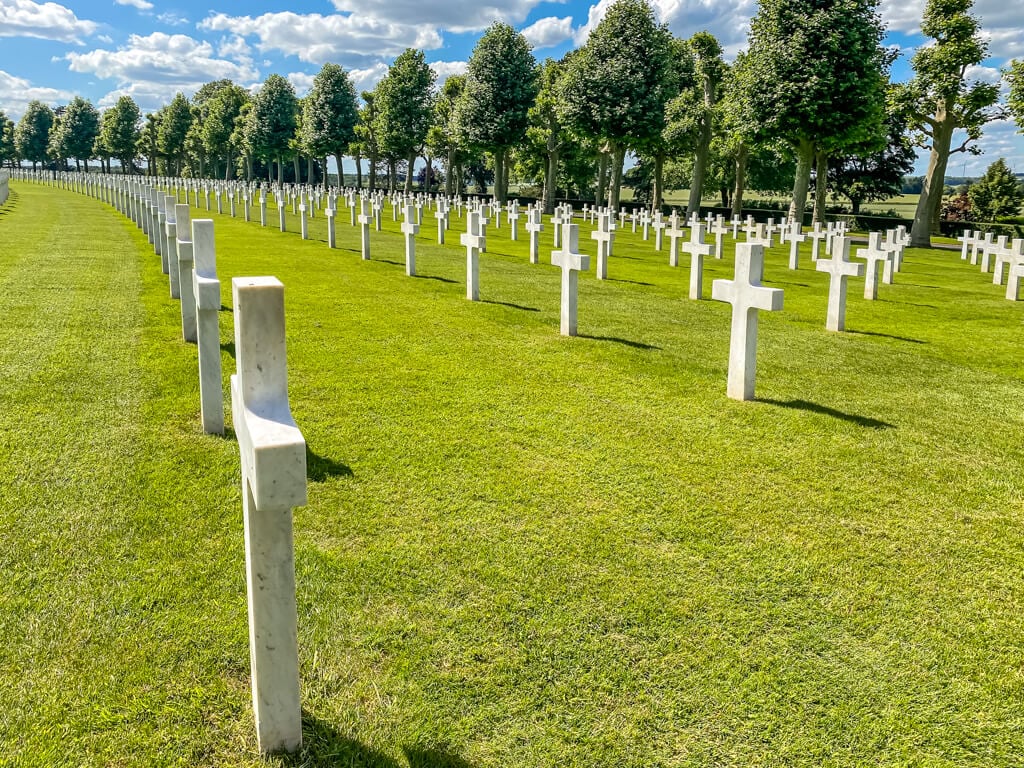
Adjacent to Belleau Wood you will find the Aisne-Marne American Cemetery and Memorial. The first thing you notice when you turn in the gate is the tall light-colored chapel at the top of the hill. Walk closer and you will see the graves of 2,289 war dead, most of whom fought in the area during the summer of 1918.
The white headstones, all either a Latin Cross or Star of David, are arranged in sweeping curved lines on either side of a perfectly mowed grassy area and flower beds. There are a few benches where you can sit and reflect.
Climb the steps to the memorial chapel constructed in the Romanesque style. Inside you can see the names of the 1,060 soldiers missing. Rosettes next to the names mean that the body has since been recovered and identified.
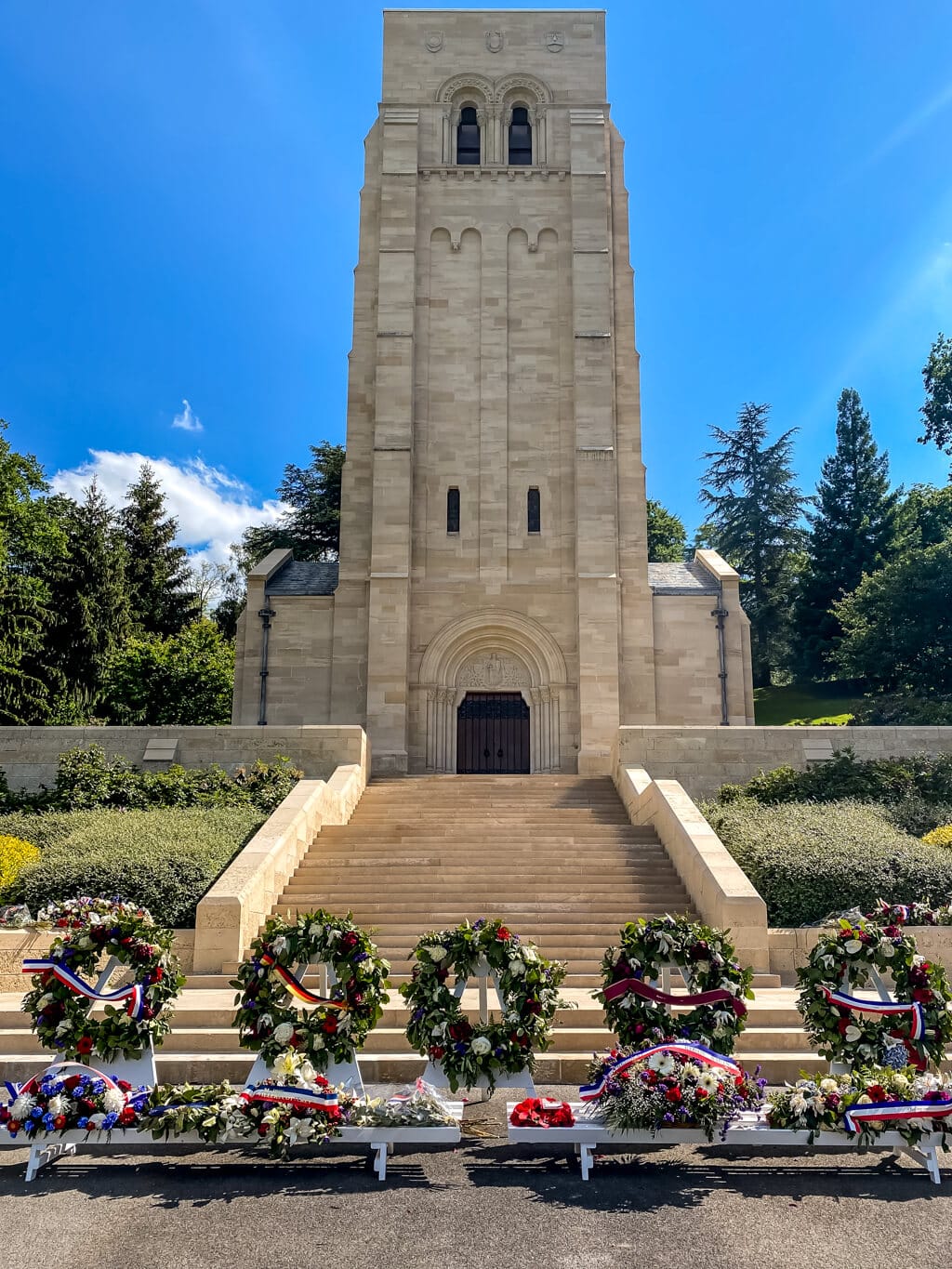
In 1940 during World War II the Aisne-Marne American Cemetery chapel was damaged. While it was repaired, you can still see one large shell hole from a tank to the right of the door, left as a reminder of what took place.
We were lucky to be present for the flag ceremony at the end of the day. Both flags were lowered in unison while Taps played over speakers and I got a bit emotional.
It is free to visit the Aisne-Marne American Cemetery. Get more details here.
Oise-Aisne American Cemetery
The Oise-Aisne American Cemetery and Memorial contains the remains of 6,012 American war dead, most of whom lost their lives while fighting nearby in 1918. The burial area is divided into four plots by wide paths lined by trees and beds of roses with a circular plaza and the flagpole in the center.
At the far end, there is a curving colonnade memorial made of rose-colored sandstone with white trim. It has sculptured details of wartime equipment.
At one end of the memorial, you will find a chapel with a carved stone altar and walls engraved with 241 names of the missing.The map room located opposite the chapel has an engraved and colored wall map portraying the military operations in this region during 1918.
It is free to visit the Oise-Aisne American Cemetery. Get more details here.
Learning about World War I in Aisne
It was quite an eye-opening experience visiting these World War I sites in Aisne. I knew World War I had been terrible but I had underestimated the extent of the devastation.
It wasn’t just all the soldiers that died and the buildings that were destroyed, but the lasting impact it had on civilians. When the war ended, it took years (maybe decades) for families to recover.
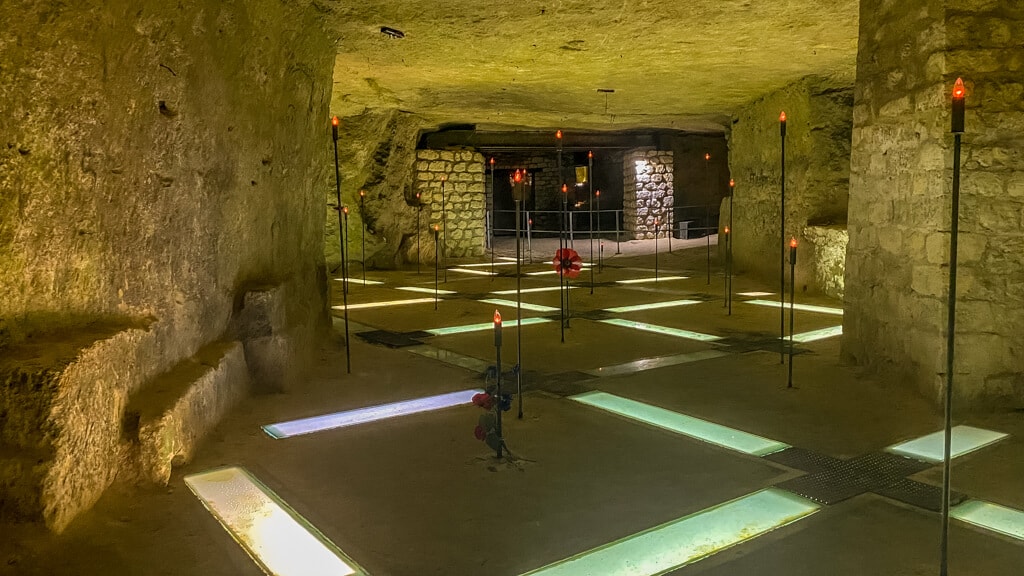
It was particularly poignant to drive away from some of these sites and see the poppies growing in the surrounding fields. The poppy is used as a symbol of remembrance in both the US and the UK. Now we could see why.
I thought a lot about what is happening in Ukraine and wondered how it could have come to this after the lessons from previous wars. The people of Ukraine don’t deserve this. I will keep hoping for peace, but know it is going to take awhile for the country to recover once the fighting stops. They will need our help.
Have you visited any Great War sites in Aisne? I would love to hear your experience in the comments.
-Anisa
Pin for Later
Expert Tips for Visiting Sites of the Great War in Aisne
- Ideally, you will want a few days to be able to see these World War I sites. If you only have a day, you need to focus on a small area.
- You will need a car, as most of the places are located outside towns and cities.
Disclosure: This post contains affiliate links. As an Amazon Associate I earn from qualifying purchases.
This means we will receive a small commission for some purchases made using links in our blog with no additional cost to you. Please be assured we would not promote any product unless we believe that our readers will also benefit. The commission does not influence the editorial content of this site.
Last Updated on June 30, 2022

